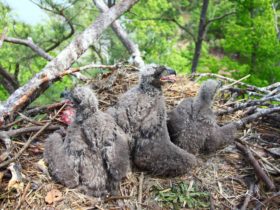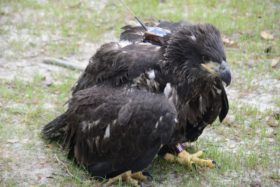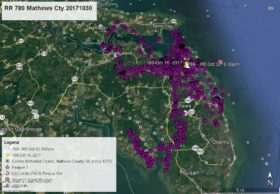Catfish Pond Visit
Camellia Near West Point, VA
July 16, 2010Camellia Flies Further North
July 19, 2010

On Thursday July 15 I made a visit to the Tidewater Research Station operated by the North Carolina Dept. of Agriculture near Plymouth, NC to see if I could locate Azalea and to see if there were any other bald eagles wearing purple leg bands. Our last satellite data as of 6:00pm July 14 showed that Azalea was perched in a tree near the TRS fish ponds, so that is where I went. Since this is a restricted access site, I made arrangements with the manager before going. TRS is involved with many aspects of agriculture research including crops, cattle and fish.
When I arrived at 7:00am the area was fog bound, but by 7:30 the fog began to burn off and the temperature began to rise to broiling. So, did I find Azalea or any other banded eagles? NO!! However, the trip was very productive. I did find about 40 bald eagles and was able to see the legs of 30 of them to determine they wore no bands. Seven of the eagles were adults including two that were first year adults – still had a few brown feathers in their head. A few were 4-year olds with head and tail feathers beginning to turn white. The others were younger with many being first year eagles born this year. The really big question is – where did they all come from? Only one bald eagle nest is known about locally. Every time an eagle flew I checked it with my binocs to see if it had an antenna – no Azalea.
In the top photo taken as the fog was lifting there are 8 eagles in the two trees. One is hard to see because it is mostly behind the lower tree trunk on the right. Only adult is on far right. The rest are immature. The bottom photo was taken later in the morning on the far east side of the catfish ponds from a public road. There are 10 eagles in this pine tree, a couple hard to see, but they are there. One adult on far left, two 4-year olds and 7 immature. Photos by Reese F. Lukei Jr.




13 Comments
The pictures are great Reese and when enlarged can plainly see if there were and bands. Thank you so much for taking time to look for Azalea….we appreciate it !
Reese,in the second photo,is that tree from the swampy area off Gourd Neck Rd. that Azalea has spent so much time at?
Can you find all the Eagles. Interesting.
Mike F – Not Gourd Neck Rd. I did not find any eagles there. Taken from dirt road Research Station Rd not far from Rt 64.
What wonderful pictures Reese. Sure would be nice if the Nesti group could take a field trip there.
What wonderful pictures Reese. Sure would be nice if the Nesti group could take a field trip there.
Azalea sure doesn’t want to be found. Wish you had seen her there. We are all anxious to see her. Maybe next time. If none of these have purple bands, one wonders where they are.
Violet
Love the pictures-so cool!
Great pictures! So sorry you didn’t find Azalea or any banded birds. Hopefully some will show up soon!
nice pictures,and I see one flying high in the second pic.
Even tho you didn’t find AZ, it still looks like it was an interesting trip with all those sightings! Thanks for the post, Reese.
Thanks for the update. Sorry no Azalea but the numbers of eagles are interesting–especially for your studies!
Would love to see that many eagles at once–would be a real treat.
Thanks for the pictures. Sounds as though it might have been beneficial for your other research efforts. Would love to see that many eagles in one location.